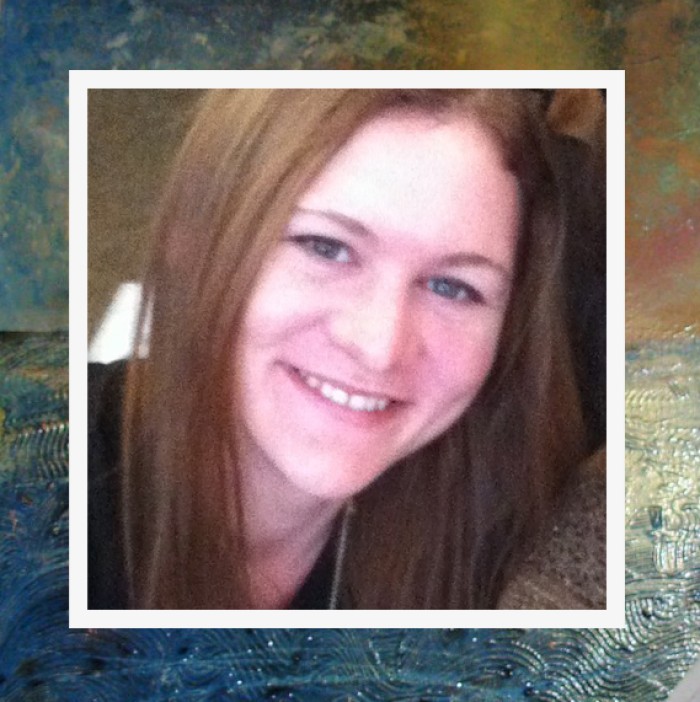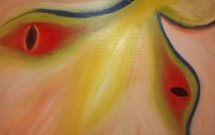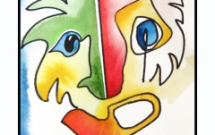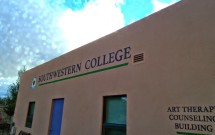
The Mirror and Portal of Art
by Allegra E. Borghese
I have been studying art therapy formally for a little over a year. Really though, it has been much longer. While my initial creative interest was fashion design, it lost its luster when a series of events cast me into a dark night of the soul. My reaction to the perceived loss was rejecting art and chasing forms of self-medication, a dependence which leveled me. When I eventually felt my resolve to recover, I thought art would be an important component. This time, drawing seasonal evening wear was not going to cut it. I needed a deeper and richer experience. That is when an artist-turned-garbage-collector came to lead me in rediscovering the alchemy of my creative process.
His name was Jeffrey. Despite having an impressive art school education and professional following, he was most happy salvaging the jewels others saw as trash. His garbage collection business fueled his imagination and art. Piles of chicken wire, massive stencil sets, broken objects, metallurgy tools and masonite boards filled the corners of his basement studio. Hundreds of paints lined the walls: house paints, spray paints, inks, polyurethanes, stains, acrylics, oils, dyes and more. Dozens of his artworks hung, attesting to the evolution in one’s artistic identity over a span of fifty years. As I stood in the basement, I felt enmeshed in a vortex of possibility.
“What do you want to make?” he asked, Marlboro in mouth, Bud Light in hand.
“Um, a sailboat,” I said shyly, trying to contain my excitement.
“Great, let’s tackle it. Only two rules: 1. Have fun, and 2. Don’t give up.” He turned up the radio and tossed a masonite board in my direction.
I didn’t know what to expect when I agreed to work with him. I just showed up in paint-worthy clothes and an open mind. I definitely did not expect my impulses for destruction to be indulged and gently guided over the course of five years. Jeffrey encouraged me to experiment and explore endlessly in the studio. I mixed bleach, inks and powdered metals just because I wanted to; I stabbed, ripped and molded foam board; I hose-blasted polyurethane to isolate bubble formations, to be captured by angled spray painting; and I blow-torched my way through concrete, unsuccessfully. The materials and techniques became the vehicle by which I broke down the self-constructed rules that controlled my mind. I found new limits, and began to trust my curiosity again.
“The Sail” by Allegra E. Borghese
“Just do it” used to be the constant echo steering me in my choices. I can hardly call them choices, as the surge of compulsion overtook any feeling of option in the matter. My internal voice said to just snort it, eat it, purge it, cut in, pick it, suck in, chug it, stuff it, smoke it, steal it, deny it, hide it, and keep running till collapse. My art process reflected this dire thirst for experience. I threw myself into all facets of the work, as I do with most things. But this time there was a return on my investment. The deeper I explored the closer I came to the abandoned pieces of myself: the memories, impulses, feelings, fears, and strengths that were once too much to hold. Now they were here, right in front of me, in the art.
Not being able to paint something has the potential to launch my inner critic to shout horrible things about myself. However, both the art and Jeffrey taught me how to make space for and tolerate failure. Over time the threat of disappointment stopped determining my actions. With the art as my guide, I waded into the present moment and touched my capacity for conscious choice. This is when the importance of what I was doing really landed in me: one can make meaning out of nothing, make love out of tragedy, and make art out of garbage. It starts with the willingness to simply show up and make something. Art taught me, and continues to teach me, that the inherent gift in repetitive failure is cultivating the strength to get up and try again. It is the type of strong that changes the world. And thankfully, there is a profession that allows me to continue this journey.
Art Therapy attracts people from many different backgrounds, but maybe we can agree on at least one thing: you don’t have to be an artist in the traditional sense to experience the transformative power in creating. My clients show me how anyone willing can be an artist. I witness how the art brings a person to meet themselves, which can be anything from excruciating to graceful. Regardless, it is beautiful, meaningful and never the same. This practice returns a person to the body, bridging spirit and materiality, inner and outer, and self with other. One cannot quantify exactly how or why the art is a reliable factor in the invitation for consciousness. It is a mystery that is forever unfolding.
Art is a way of knowing the self, the world, another, the human condition, spirit, anything. Pick up an instrument and do something. Make, create, shape, cut, sew, paint, draw, build, burn, construct, sculpt, nail, glue, tape, tack, fasten, change, mold, give, breathe and go do art. You never know what can happen. I never saw myself pursuing a counseling degree in Santa Fe, NM (I am from New York). Five years ago I had not even heard of Art Therapy. It’s about taking the next available step, and when you run into a block, an answer is waiting within the art.
Rest In Peace: Jeffrey Abrams, 1949-2013.
Allegra E. Borghese
Allegra E. Borghese is a Practicum Art Therapy/Counseling Student at The Southwestern Counseling Center in Santa Fe, NM. She attends Southwestern College, a holistic graduate school committed to Transforming Consciousness Through Education. Her goals in the field are to help adolescents and adults in recovery from eating disorders and addictions. Contact: aeborghese@gmail.com.
 Southwestern College Santa Fe, NM
Southwestern College Santa Fe, NM







